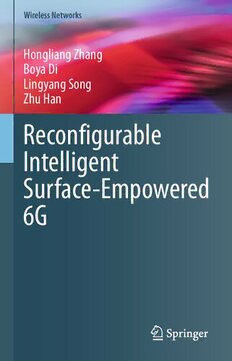
Reconfigurable Intelligent Surface-Empowered 6G (Wireless Networks) PDF
Preview Reconfigurable Intelligent Surface-Empowered 6G (Wireless Networks)
Wireless Networks Hongliang Zhang Boya Di Lingyang Song Zhu Han Reconfigurable Intelligent Surface-Empowered 6G Wireless Networks SeriesEditor XueminShermanShen,UniversityofWaterloo,Waterloo,ON,Canada The purpose of Springer’s Wireless Networks book series is to establish the state of the art and set the course for future research and development in wireless communication networks. The scope of this series includes not only all aspects of wireless networks (including cellular networks, WiFi, sensor networks, and vehicular networks), but related areas such as cloud computing and big data. The series serves as a central source of references for wireless networks research and development. It aims to publish thorough and cohesive overviews on specific topics in wireless networks, as well as works that are larger in scope than survey articles and that contain more detailed background information. The series also providescoverageofadvancedandtimelytopicsworthyofmonographs,contributed volumes,textbooksandhandbooks. **Indexing:WirelessNetworksisindexedinEBSCOdatabasesandDPLB** Moreinformationaboutthisseriesathttp://www.springer.com/series/14180 Hongliang Zhang (cid:129) Boya Di (cid:129) Lingyang Song Zhu Han Reconfigurable Intelligent Surface-Empowered 6G 123 HongliangZhang BoyaDi PrincetonUniversity ImperialCollegeLondon Princeton,NJ,USA London,UK LingyangSong ZhuHan PekingUniversity UniversityofHouston Beijing,China Houston,TX,USA ISSN2366-1186 ISSN2366-1445 (electronic) WirelessNetworks ISBN978-3-030-73498-5 ISBN978-3-030-73499-2 (eBook) https://doi.org/10.1007/978-3-030-73499-2 ©TheEditor(s)(ifapplicable)andTheAuthor(s),underexclusivelicensetoSpringerNatureSwitzerland AG2021 Thisworkissubjecttocopyright.AllrightsaresolelyandexclusivelylicensedbythePublisher,whether thewholeorpartofthematerialisconcerned,specificallytherightsoftranslation,reprinting,reuse ofillustrations,recitation,broadcasting,reproductiononmicrofilmsorinanyotherphysicalway,and transmissionorinformationstorageandretrieval,electronicadaptation,computersoftware,orbysimilar ordissimilarmethodologynowknownorhereafterdeveloped. Theuseofgeneraldescriptivenames,registerednames,trademarks,servicemarks,etc.inthispublication doesnotimply,evenintheabsenceofaspecificstatement,thatsuchnamesareexemptfromtherelevant protectivelawsandregulationsandthereforefreeforgeneraluse. Thepublisher,theauthors,andtheeditorsaresafetoassumethattheadviceandinformationinthisbook arebelievedtobetrueandaccurateatthedateofpublication.Neitherthepublishernortheauthorsor theeditorsgiveawarranty,expressedorimplied,withrespecttothematerialcontainedhereinorforany errorsoromissionsthatmayhavebeenmade.Thepublisherremainsneutralwithregardtojurisdictional claimsinpublishedmapsandinstitutionalaffiliations. ThisSpringerimprintispublishedbytheregisteredcompanySpringerNatureSwitzerlandAG Theregisteredcompanyaddressis:Gewerbestrasse11,6330Cham,Switzerland Preface Launchingfromfifth-generationcommunications,whichprovideasingleplatform enablingavarietyofdataservices,evolutiontowardssixth-generation(6G)hasbeen kicked off, envisioning future wireless networks to become distributed intelligent communications, sensing, and localization systems. Though such a demand has gained support from existing techniques such as massive MIMO and small cells, they heavily depend on the quality of the uncontrollable wireless environments. Differently, reconfigurable intelligent surface (RIS) as a new type of ultra-thin meta material inlaid with multiple sub-wavelength scatters can create favorable propagationconditionsbycontrollingthephaseshiftsofthereflectedwavesatthe surface such that the received signals are directly reflected towards the receivers without any extra cost of power sources or hardware. It provides a revolutionarily newapproachtoactivelyimprovethelinkqualityandcoverage,whichshedslight into the future 6G. Due to the coupling between radio propagation and discrete phaseshiftsofRIS,existingprotocolsanddesignmethodologiescannotbedirectly applied any more. Therefore, it is essential to develop new communication and signal processing techniques and to explore various RIS-based applications such asintelligentsensingandlocalization. In this book, novel RIS-based smart radio techniques are discussed, targeting at achieving high-quality channel links in cellular communications via design and optimization of RIS construction. Unlike traditional antenna arrays, three unique characteristics of RIS will be revealed. First, the built-in programmable configu- ration of RIS enables analog beamforming inherently without extra hardware or signal processing. Second, the incident signals can be controlled to partly reflect andpartlytransmitthroughtheRISsimultaneously,addingmoreflexibilitytosignal transmission.Third,RIShasnodigitalprocessingcapabilitytoactivelysendsignals noranyradiofrequency(RF)components.Assuch,itisnecessarytodevelopnovel channelestimationandcommunicationprotocols,designjointdigitalandRIS-based analogbeamformingschemes,andperforminterferencecontrolviamixedreflection andtransmission. v vi Preface Benefitedfromitsabilitytoactivelyshapethepropagationenvironment,theRIS techniqueisfurtherinvestigatedtoachievetwotypesofwirelessapplications,that is,RFsensingandlocalization. (cid:129) In RF sensing, the influence of the sensing objectives on the wireless signal propagationcanbepotentiallyrecognizedbythereceivers,whichisthenutilized to identify the objectives. Unlike traditional sensing techniques, RIS-aided sensing can actively customize the wireless channels and generate a favorable massive number of independent paths interacting with the sensing objectives. It is desirable to design RIS-based image recovery algorithms, optimize RIS configurations,andstudyefficienttrackingmethods. (cid:129) For the second application, that is, RIS aided localization, RIS is deployed between the access point (AP) and users such that the AP can analyze the reflectedsignalsfromusersviadifferentRISconfigurationstoobtaintheaccurate locations of users. However, this is a challenging task due to the dynamic user topology as well as the mutual influence between multiple users and the RIS. Therefore, the operations of RIS, AP, and multiple users need to be carefully coordinated. AnewRIS-based localization protocol fordevice cooperation and anRISconfigurationoptimizationalgorithmarealsorequired.Implementations with respect to different real-world scenarios will be delivered to illustrate the proposedapproachesseparatelyintheaboveapplications. The aim of this book is to educate control and signal processing engineers, computer and information scientists, applied mathematicians and statisticians, as well as systems engineers to carve out the role that analytical and experimental engineeringhastoplayinRISresearchanddevelopment.Thisbookwillemphasize onRIStechnologiesandapplicationsforfuturecommunications. This book is organized as below. Chapter 1 provides an overview of RISs and introduces fundamentals of RIS aided wireless communications. In Chap.2, we present some study cases on RIS-aided multi-input multi-output (MIMO) communications.InChap.3,weshowhowtointegrateRISsintoexistingwireless technologies.Finally,inChap.4,wegivestudycasestoshowthepossibleapplica- tionsinRFsensingandlocalization. Princeton,NJ,USA HongliangZhang London,UK BoyaDi Beijing,China LingyangSong Houston,TX,USA ZhuHan Contents 1 IntroductionsandBasics ................................................... 1 2 RISAidedMIMOCommunications ...................................... 19 3 ConvergencesofRISswithExistingWirelessTechnologies ............ 105 4 RISAidedRFSensingandLocalization .................................. 161 vii Acronyms 2D Two-Dimensional 3D Three-Dimensional 5G Fifth-Generation 6G Sixth-Generation ADC Analog-DigitalConverter AF Amplify-and-Forward AoA Angle-of-Arrival AP AccessPoint BS BaseStation CDF CumulativeDistributionFunction CPU CentralProcessingUnit CSI ChannelStateInformation DAS DistributedAntennaSystem DC DifferenceofConcave/ConvexFunctions DF Decode-and-Forward D2D Device-to-Device EM Electromagnetic eMBB EnhancedMobileBroadband FGPA Field-ProgrammableGateArray GPS GlobalPositioningSystem HBF HybridBeamforming IRS IntelligentReflectingSurface ISI Inter-symbolInterference IOS IntelligentOmni-surface IoT Internet-of-Things LNA Low-NoiseAmplifiers LoS Line-of-Sight MDP MarkovDecisionProcess MIMO Multiple-InputandMultiple-Output MLP Multi-LayerPerceptrons mMTC MassiveMachineTypeCommunications ix x Acronyms MU MobileUser NLoS Non-Line-of-Sight NN NeuralNetwork PIN PositiveIntrinsicNegative PPS Pulses-per-Second QoS QualityofServices RF RadioFrequency RFID RadioFrequencyIdentification RIS ReconfigurableIntelligentSurface RSS ReceivedSignalStrength SA SimulatedAnnealing SBS SmallBaseStation SDP Semi-definiteProgram SINR Signal-to-Interference-plus-NoiseRatio SNR Signal-to-NoiseRatio SOI SpaceofInterest TOA Time-of-Arrival TDM TimeDivisionMultiplex UAV UnmannedAerialVehicle UE UserEquipment URLLC Ultra-reliableandLowLatencyCommunications USRP UniversalSoftwareRadioPeripheral WLAN WirelessLocalAreaNetwork ZF Zero-Forcing
